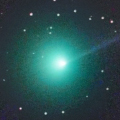
|
Now it is 8.2 mag (Oct. 12, Virgilio Gonano). It will fade out rapidly after this. It will be fainter than 18 mag in January. It will never be observable after this.
Date(TT) R.A. (2000) Decl. Delta r Elong. m1 Best Time(A, h)
Oct. 21 12 50.53 -5 15.0 1.222 0.342 13 7.5 4:46 (273, -5)
Oct. 28 13 45.37 -13 7.7 1.349 0.370 5 7.9 4:51 (277,-13)
|
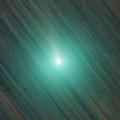
|
Now it is 8.4 mag (Oct. 16, Marek Biely). It will fade out rapidly after this. It stays observable in good condition.
Date(TT) R.A. (2000) Decl. Delta r Elong. m1 Best Time(A, h)
Oct. 21 7 59.45 13 59.0 0.431 1.071 87 7.5 4:46 (315, 63)
Oct. 28 8 19.23 8 42.5 0.455 1.086 88 7.5 4:51 (327, 60)
|

|
It brightened very rapidly. It will approach to Earth down to 0.2 a.u. in November, and it is expected to brighten up to 7.5 mag. Now it is 9.4 mag (Oct. 20, Seiichi Yoshida). It will turn to fade out rapidly after brightening. In the Northern Hemisphere, it will be unobservable in January. But it will be observable again in November. In the Southern Hemisphere, it is not observable now, but it will appear in November.
Date(TT) R.A. (2000) Decl. Delta r Elong. m1 Best Time(A, h)
Oct. 21 12 40.10 48 17.3 0.770 0.907 60 10.0 4:46 (228, 26)
Oct. 28 13 20.20 49 50.3 0.539 0.895 63 9.2 4:51 (226, 25)
|
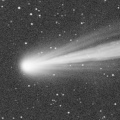
|
It approached to Sun down to 0.23 a.u. and brightened up to 2.5 mag in mid September (Sept. 18, Juan Jose Gonzalez). Fading rapidly. It will be fainter than 18 mag in January. In the Northern Hemisphere, it is not observable now, but it will appear in November. In the Southern Hemisphere, it will be getting higher gradually.
Date(TT) R.A. (2000) Decl. Delta r Elong. m1 Best Time(A, h)
Oct. 21 12 55.78 -26 52.0 1.841 0.962 19 10.2 4:46 (291,-18)
Oct. 28 12 55.50 -29 54.9 1.944 1.109 23 11.2 4:51 (298,-13)
|
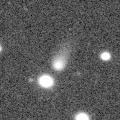
|
It is expected to brighten up to 7 mag in early 2024. Now it is 12.3 mag (Sept. 16, Jose G. S. Aguiar). It will brighten rapidly after this. In the Northern Hemisphere, it is not observable now, but it will appear in November. It locates somewhat low in the Southern Hemisphere. But it will become high in winter. The brightness evolution slowed down since May.
Date(TT) R.A. (2000) Decl. Delta r Elong. m1 Best Time(A, h)
Oct. 21 10 54.39 -35 34.1 2.701 2.121 45 10.4 4:46 (313, -2)
Oct. 28 11 13.98 -36 36.7 2.622 2.049 45 10.2 4:51 (316, -1)
|

|
Now it is 10.1 mag (Oct. 20, Juan Jose Gonzalez). Fading gradually. In the Northern Hemisphere, it will be unobservable in January. In the Southern Hemisphere, it stays observable in good condition.
Date(TT) R.A. (2000) Decl. Delta r Elong. m1 Best Time(A, h)
Oct. 21 0 37.26 -39 57.5 2.185 2.902 127 10.3 22:37 ( 0, 15)
Oct. 28 0 19.17 -41 28.0 2.322 2.950 120 10.5 21:52 ( 0, 14)
|
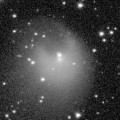
|
It returns for the first time in 70 years. It will brighten up to 4.5 mag in 2024 spring. It suddenly brightened in outburst by 5 mag up to 11.5 mag on July 20 (E. Tamas, Francois Kugel). It brightened again in another outburst up to 11.7 mag on Oct. 5 (Richard Miles). Now it is 11.8 mag (Oct. 11, Osamu Miyazaki). It will brighten rapidly after this. In the Northern Hemisphere, it stays observable in good condition. In the Southern Hemisphere, it is not observable now.
Date(TT) R.A. (2000) Decl. Delta r Elong. m1 Best Time(A, h)
Oct. 21 17 31.47 43 27.6 2.968 2.879 75 11.4 18:43 (118, 53)
Oct. 28 17 37.91 42 23.7 2.915 2.798 73 11.3 18:35 (116, 50)
|

|
It will fade out rapidly after this. It will be fainter than 18 mag in January. Now it is not observable. It will appear in November.
Date(TT) R.A. (2000) Decl. Delta r Elong. m1 Best Time(A, h)
Oct. 21 13 50.68 -12 56.1 1.119 0.140 3 11.5 18:43 ( 85,-16)
Oct. 28 15 21.48 -11 50.9 0.934 0.311 18 14.9 18:35 ( 77, -2)
|

|
It brightened up to 8 mag from 2022 summer to 2023 spring. Now it is 11.9 mag (Oct. 21, Osamu Miyazaki). Fading slowly. It stays observable in good condition.
Date(TT) R.A. (2000) Decl. Delta r Elong. m1 Best Time(A, h)
Oct. 21 6 44.77 -8 15.9 3.641 3.969 101 12.1 4:46 (359, 47)
Oct. 28 6 41.03 -8 11.0 3.601 4.032 108 12.2 4:18 ( 0, 47)
|

|
It is expected to brighten up to 7 mag, and it will be observable in good condition in winter. Now it is 12.5 mag (Oct. 15, Katsumi Yoshimoto). Brightening rapidly. In the Northern Hemisphere, it stays observable in good condition. It locates somewhat low in the Southern Hemisphere. But it will become high in winter.
Date(TT) R.A. (2000) Decl. Delta r Elong. m1 Best Time(A, h)
Oct. 21 7 8.01 21 56.8 0.917 1.479 101 13.5 4:46 (334, 76)
Oct. 28 7 32.65 21 47.2 0.848 1.439 102 12.4 4:51 (342, 76)
|

|
It brightened up to 7.8 mag in late July (July 20, Thomas Lehmann). Now it is 12.9 mag (Oct. 3, Chris Wyatt). Fading slowly. Now it is not observable. It will appear in November in the Northern Hemisphere, or in December in the Southern Hemisphere.
Date(TT) R.A. (2000) Decl. Delta r Elong. m1 Best Time(A, h)
Oct. 21 14 58.82 -11 42.0 2.773 1.862 19 12.4 18:43 ( 78, -3)
Oct. 28 15 1.22 -11 12.4 2.873 1.920 13 12.6 18:35 ( 81, -6)
|
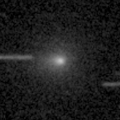
|
Now it is 12.8 mag (Oct. 17, Ken-ichi Kadota). It will fade out rapidly after this. In the Northern Hemisphere, it stays observable in good condition. It locates somewhat low in the Southern Hemisphere.
Date(TT) R.A. (2000) Decl. Delta r Elong. m1 Best Time(A, h)
Oct. 21 17 27.71 -5 29.2 1.227 1.071 56 12.7 18:43 ( 58, 30)
Oct. 28 18 1.43 -5 5.3 1.205 1.087 58 12.8 18:35 ( 55, 32)
|

|
Now it is 13.7 mag (July 14, Chris Wyatt). It stays 13 mag for a while. It stays extremely low in the Northern Hemisphere. In the Southern Hemisphere, it will be getting higher gradually.
Date(TT) R.A. (2000) Decl. Delta r Elong. m1 Best Time(A, h)
Oct. 21 10 46.02 -25 14.6 4.722 4.063 43 13.2 4:46 (307, 6)
Oct. 28 10 46.30 -26 48.2 4.675 4.091 48 13.2 4:51 (314, 10)
|

|
It brightened up to 8.3 mag in 2021-2022 winter (Jan. 6, 2022, Toshiyuki Takahashi). Now it is 13.2 mag (July 14, Chris Wyatt). It stays 14 mag for a while. In the Northern Hemisphere, it is not observable now, but it will appear in November. In the Southern Hemisphere, it will be getting higher gradually.
Date(TT) R.A. (2000) Decl. Delta r Elong. m1 Best Time(A, h)
Oct. 21 11 2.26 -39 35.8 7.223 6.564 45 13.8 4:46 (315, -6)
Oct. 28 11 6.76 -40 32.9 7.232 6.610 48 13.9 4:51 (320, -3)
|
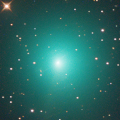
|
It brightened up to 8.4 mag in late July (July 22, Thomas Lehmann). Now it is 12.0 mag (Oct. 6, Osamu Miyazaki). Fading rapidly. It will be fainter than 18 mag in December. It stays observable in good condition.
Date(TT) R.A. (2000) Decl. Delta r Elong. m1 Best Time(A, h)
Oct. 21 22 40.86 -24 48.0 1.249 1.985 123 13.8 20:43 ( 0, 30)
Oct. 28 22 47.46 -25 18.1 1.400 2.065 118 14.4 20:22 ( 0, 30)
|

|
Now it is 12.1 mag (Oct. 15, Hiroshi Abe). In the Northern Hemisphere, it stays observable in good condition. It locates somewhat low in the Southern Hemisphere.
Date(TT) R.A. (2000) Decl. Delta r Elong. m1 Best Time(A, h)
Oct. 21 8 38.16 20 59.7 6.231 6.146 80 13.9 4:46 (291, 61)
Oct. 28 8 40.35 20 50.0 6.120 6.148 86 13.8 4:51 (301, 66)
|
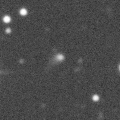
|
Now it is 14.6 mag (Oct. 15, Hiroshi Abe). Brightening slowly. In the Northern Hemisphere, it stays observable in good condition. In the Southern Hemisphere, it will be getting higher gradually. It is expected to brighten up to 12 mag from 2024 to 2025.
Date(TT) R.A. (2000) Decl. Delta r Elong. m1 Best Time(A, h)
Oct. 21 9 42.38 4 51.9 5.067 4.668 61 14.1 4:46 (295, 38)
Oct. 28 9 43.07 5 10.4 4.913 4.632 67 14.0 4:51 (302, 44)
|
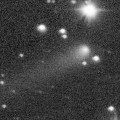
|
Now it is 14.3 mag (Oct. 12, Hiroshi Abe). Fading slowly. It will be getting lower gradually after this, and it will be unobservable in January in the Southern Hemisphere, or in February in the Northern Hemisphere.
Date(TT) R.A. (2000) Decl. Delta r Elong. m1 Best Time(A, h)
Oct. 21 23 35.61 4 37.7 2.632 3.520 148 14.1 21:36 ( 0, 60)
Oct. 28 23 21.62 4 8.6 2.743 3.547 138 14.2 20:55 ( 0, 59)
|
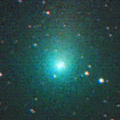
|
It brightened up to 9.5 mag from last winter to early spring (Jan. 30, Katsumi Yoshimoto). Now it is 13.9 mag (Oct. 17, Osamu Miyazaki). It will fade out rapidly after this. It will be getting lower gradually after this, and it will be unobservable in February.
Date(TT) R.A. (2000) Decl. Delta r Elong. m1 Best Time(A, h)
Oct. 21 22 41.69 -4 55.0 2.660 3.417 132 14.1 20:43 ( 0, 50)
Oct. 28 22 37.62 -6 49.4 2.822 3.482 124 14.3 20:12 ( 0, 48)
|

|
Now it is 14.0 mag (Oct. 14, Chris Wyatt). Fading slowly. In the Northern Hemisphere, it is not observable now. In the Southern Hemisphere, it stays observable in good condition. It was expected to brighten up to 10 mag from spring to summer. However, it was fainter than originally expected.
Date(TT) R.A. (2000) Decl. Delta r Elong. m1 Best Time(A, h)
Oct. 21 12 1.48 -77 39.0 3.705 3.465 68 14.1 4:46 (346,-32)
Oct. 28 12 3.40 -78 42.6 3.753 3.496 67 14.2 4:51 (348,-31)
|

|
The ATLAS search program detected its cometary activity in April. It continues to be brightening even after the perihelion passage. Now it is 14.4 mag (Oct. 14, Chris Wyatt). It will fade out rapidly after this. It will be fainter than 18 mag in January. It stays observable in good condition.
Date(TT) R.A. (2000) Decl. Delta r Elong. m1 Best Time(A, h)
Oct. 21 23 31.51 -24 58.4 2.446 3.206 132 14.3 21:33 ( 0, 30)
Oct. 28 23 30.88 -24 5.6 2.548 3.244 126 14.5 21:05 ( 0, 31)
|
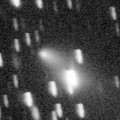
|
It brightened up to 13.6 mag in summer (July 16, Mitsunori Tsumura). Now it is 14.9 mag (Oct. 12, Thomas Lehmann). It will fade out rapidly after this. It will be fainter than 18 mag in February. In the Northern Hemisphere, it stays observable in good condition. In the Southern Hemisphere, it will never be observable after this.
Date(TT) R.A. (2000) Decl. Delta r Elong. m1 Best Time(A, h)
Oct. 21 0 51.85 70 10.2 1.379 2.062 119 14.6 22:51 (180, 55)
Oct. 28 0 21.77 70 41.8 1.423 2.103 119 14.8 21:54 (180, 54)
|
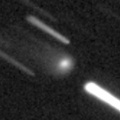
|
Now it is 14.9 mag (Sept. 18, Ken-ichi Kadota). Brightening slowly. In the Northern Hemisphere, it will be unobservable in November. But it will be observable again in December. In the Southern Hemisphere, it is not observable now, but it will appear in December. It is expected to brighten up to 12.5 mag in 2024 spring. At the high light, it will be observable in excellent condition in the Southern Hemisphere, but it will be low in the Northern Hemisphere.
Date(TT) R.A. (2000) Decl. Delta r Elong. m1 Best Time(A, h)
Oct. 21 15 11.08 -4 41.1 3.965 3.075 23 14.7 18:43 ( 82, 4)
Oct. 28 15 12.92 -5 59.8 3.974 3.042 17 14.6 18:35 ( 83, -1)
|
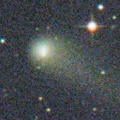
|
It brightened up to 11.1 mag in early 2022 (Mar. 31, 2022, F. Kugel, J.-G. Bosch, J. Nicolas). Now it is 14.4 mag (Oct. 6, Ken-ichi Kadota). It stays 15 mag for a while. It locates somewhat low in the Northern Hemisphere. But it will become high in winter. In the Southern Hemisphere, it is not observable now, but it will appear in February.
Date(TT) R.A. (2000) Decl. Delta r Elong. m1 Best Time(A, h)
Oct. 21 16 0.63 16 11.4 6.527 5.848 43 14.7 18:43 ( 92, 25)
Oct. 28 16 6.35 15 58.9 6.595 5.885 41 14.8 18:35 ( 94, 22)
|

|
Now it is 15.2 mag (July 22, ATLAS Chile). It stays 14 mag for a while. In the Northern Hemisphere, it will be unobservable in November. But it will be observable again in November. In the Southern Hemisphere, it will be getting higher gradually.
Date(TT) R.A. (2000) Decl. Delta r Elong. m1 Best Time(A, h)
Oct. 21 11 14.98 -30 54.8 6.296 5.563 39 14.9 4:46 (307, -2)
Oct. 28 11 21.46 -31 30.2 6.235 5.540 42 14.9 4:51 (311, 2)
|

|
It will approach to Sun down to 0.4 a.u. in late September in 2024, and it is expected to brighten up to 0 mag. Now it is 15.3 mag (Sept. 10, A. Ivanov et al.). Brightening gradually. Now it is not observable. It will appear in November in the Northern Hemisphere, or in December in the Southern Hemisphere. At the high light, in the Northern Hemisphere, it will be observable in good condition after the perihelion passage. In the Southern Hemisphere, it will be observable in the low sky before and after the perihelion passage.
Date(TT) R.A. (2000) Decl. Delta r Elong. m1 Best Time(A, h)
Oct. 21 14 23.48 -3 18.9 5.993 5.028 12 15.4 18:43 ( 90, -5)
Oct. 28 14 27.01 -3 47.8 5.929 4.954 10 15.3 18:35 ( 92, -9)
|

|
It is expected to brighten up to 14.5 mag in winter. Now it is 15.5 mag (Oct. 17, Hirohisa Sato). It stays 15 mag for a while. It stays observable in good condition.
Date(TT) R.A. (2000) Decl. Delta r Elong. m1 Best Time(A, h)
Oct. 21 3 27.41 15 42.6 1.635 2.564 153 15.5 1:33 ( 0, 71)
Oct. 28 3 23.26 15 53.9 1.569 2.530 161 15.3 1:01 ( 0, 71)
|
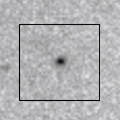
|
It is expected to brighten up to 8.5 mag from January to February. Now it is 18.0 mag (Oct. 20, ATLAS-HKO, Haleakala). Brightening rapidly. It stays observable in good condition. It is much fainter than this ephemeris recently.
Date(TT) R.A. (2000) Decl. Delta r Elong. m1 Best Time(A, h)
Oct. 21 3 2.47 21 9.8 0.806 1.767 157 15.9 1:08 ( 0, 76)
Oct. 28 3 1.30 20 47.2 0.744 1.723 164 15.4 0:39 ( 0, 76)
|

|
It has not been observed yet in this apparition. It was expected to brighten rapidly up to 15 mag in summer. But actually, it is not detected, fainter than 19 mag (Aug. 12, Martin Masek). Fading slowly. It will be unobservable in January in the Southern Hemisphere, or in February in the Northern Hemisphere.
Date(TT) R.A. (2000) Decl. Delta r Elong. m1 Best Time(A, h)
Oct. 21 18 41.69 -23 39.6 2.045 1.987 72 15.5 18:43 ( 30, 25)
Oct. 28 18 56.78 -22 51.0 2.108 1.983 69 15.6 18:35 ( 31, 25)
|

|
Now it is 14.3 mag (July 7, Thomas Lehmann). It stays 16 mag for a while. In the Northern Hemisphere, it is not observable now, but it will appear in January. It stays extremely low in the Southern Hemisphere. But it will become high in winter.
Date(TT) R.A. (2000) Decl. Delta r Elong. m1 Best Time(A, h)
Oct. 21 13 36.59 -49 20.7 3.571 2.866 38 15.5 4:46 (310,-34)
Oct. 28 13 53.68 -49 16.8 3.658 2.920 36 15.6 4:51 (311,-32)
|

|
David Rankin detected its cometary activity in June. Now it is 15.5 mag (Oct. 13, Michael Jager). Fading slowly. In the Northern Hemisphere, it stays observable in good condition. In the Southern Hemisphere, it will be getting lower gradually.
Date(TT) R.A. (2000) Decl. Delta r Elong. m1 Best Time(A, h)
Oct. 21 22 8.37 -4 12.4 1.465 2.196 125 15.6 20:11 ( 0, 51)
Oct. 28 22 12.20 -4 1.5 1.514 2.181 119 15.6 19:47 ( 0, 51)
|

|
It is expected to brighten up to 14 mag in 2024 summer. At the high light, it is not observable in the Northern Hemisphere. Now it is 16.3 mag (Oct. 17, Yukihiro Sugiyama). It stays 16 mag for a while. In the Southern Hemisphere, it stays observable in good condition.
Date(TT) R.A. (2000) Decl. Delta r Elong. m1 Best Time(A, h)
Oct. 21 3 3.45 -14 47.9 2.996 3.873 147 15.8 1:09 ( 0, 40)
Oct. 28 2 55.54 -17 10.4 2.950 3.827 147 15.7 0:34 ( 0, 38)
|
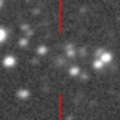
|
Now it is 16.8 mag (Oct. 16, ATLAS South Africa). Fading slowly. It will be unobservable in January.
Date(TT) R.A. (2000) Decl. Delta r Elong. m1 Best Time(A, h)
Oct. 21 18 49.78 -34 34.2 3.078 2.958 73 15.7 18:43 ( 23, 16)
Oct. 28 19 0.24 -34 37.0 3.173 2.968 69 15.8 18:35 ( 25, 15)
|

|
It approached to Earth down to 0.29 a.u. in early February, and it brightened up to 4.5 mag (Feb. 1, Juan Jose Gonzalez). Now it is 16.1 mag (Oct. 4, ATLAS Chile). Fading slowly. In the Northern Hemisphere, it will never be observable after this. In the Southern Hemisphere, it stays observable in good condition.
Date(TT) R.A. (2000) Decl. Delta r Elong. m1 Best Time(A, h)
Oct. 21 6 14.45 -55 15.0 3.726 3.911 93 15.8 4:19 ( 0, 0)
Oct. 28 6 3.42 -57 17.0 3.775 3.983 94 15.9 3:40 ( 0, -2)
|

|
It is expected to brighten up to 15 mag from autumn to winter. Now it is 16.6 mag (Oct. 17, ATLAS South Africa). It stays 16 mag for a while. In the Northern Hemisphere, it will be getting higher gradually. In the Southern Hemisphere, it stays observable in good condition.
Date(TT) R.A. (2000) Decl. Delta r Elong. m1 Best Time(A, h)
Oct. 21 1 31.03 -54 51.3 1.233 1.881 114 16.0 23:31 ( 0, 0)
Oct. 28 1 14.81 -52 1.6 1.218 1.861 114 15.8 22:47 ( 0, 3)
|

|
Now it is 15.2 mag (Oct. 17, Ken-ichi Kadota). Fading slowly. It stays observable in good condition.
Date(TT) R.A. (2000) Decl. Delta r Elong. m1 Best Time(A, h)
Oct. 21 0 12.53 -8 35.7 2.822 3.725 151 16.1 22:14 ( 0, 47)
Oct. 28 0 9.23 -8 37.2 2.893 3.740 143 16.2 21:43 ( 0, 47)
|
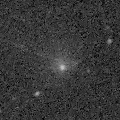
|
Very large comet. It is expected to brighten up to 13 mag in 2031. Now it is 17.2 mag (Oct. 17, ATLAS South Africa). It stays 16 mag for a while. In the Northern Hemisphere, it is not observable now. In the Southern Hemisphere, it stays observable in good condition. In the Northern Hemisphere, it is not observable until 2030.
Date(TT) R.A. (2000) Decl. Delta r Elong. m1 Best Time(A, h)
Oct. 21 3 23.57 -65 21.1 16.871 17.103 101 16.1 1:28 ( 0,-10)
Oct. 28 3 20.77 -65 35.8 16.872 17.078 100 16.1 0:58 ( 0,-11)
|

|
It brightened up to 11.8 mag in summer (June 17, Osamu Miyazaki). Now it is 15.4 mag (Oct. 10, Masayoshi Yoshimi). It will fade out rapidly after this. It will be fainter than 18 mag in December. In the Northern Hemisphere, it stays observable in good condition. In the Southern Hemisphere, it will be getting lower gradually.
Date(TT) R.A. (2000) Decl. Delta r Elong. m1 Best Time(A, h)
Oct. 21 20 12.15 -3 7.3 1.995 2.340 97 16.1 18:43 ( 11, 51)
Oct. 28 20 21.43 -3 11.9 2.100 2.367 92 16.5 18:35 ( 15, 51)
|
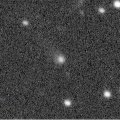
|
Now it is 16.7 mag (Oct. 18, ATLAS South Africa). It stays 16 mag for a while. In the Northern Hemisphere, it will be unobservable in November. In the Southern Hemisphere, it stays observable in good condition.
Date(TT) R.A. (2000) Decl. Delta r Elong. m1 Best Time(A, h)
Oct. 21 9 39.03 -41 22.5 4.088 3.709 60 16.2 4:46 (328, 3)
Oct. 28 9 40.85 -44 2.1 4.034 3.713 64 16.2 4:51 (335, 4)
|

|
It brightened up to 14.1 mag in 2022 spring (Mar. 22, 2022, Chris Wyatt). Now it is 16.1 mag (Oct. 18, ATLAS South Africa). Fading slowly. It stays observable in good condition.
Date(TT) R.A. (2000) Decl. Delta r Elong. m1 Best Time(A, h)
Oct. 21 2 10.14 -2 35.1 4.487 5.455 165 16.4 0:16 ( 0, 53)
Oct. 28 2 2.85 -2 29.1 4.537 5.502 164 16.5 23:36 ( 0, 53)
|
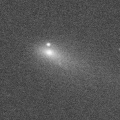
|
It brightened up to 12.8 mag in spring (Mar. 8, Taras Prystavski). Now it is 16.3 mag (Oct. 10, Masayoshi Yoshimi). It will fade out rapidly after this. It will be fainter than 18 mag in November. It stays observable in good condition.
Date(TT) R.A. (2000) Decl. Delta r Elong. m1 Best Time(A, h)
Oct. 21 0 46.09 -6 7.3 1.798 2.749 158 16.7 22:47 ( 0, 49)
Oct. 28 0 40.71 -6 7.6 1.873 2.786 151 16.9 22:15 ( 0, 49)
|
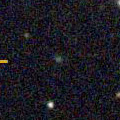
|
Now it is 17.2 mag (Oct. 17, ATLAS-HKO, Haleakala). It stays 17 mag for a while. In the Northern Hemisphere, it stays observable in good condition. It stays extremely low in the Southern Hemisphere.
Date(TT) R.A. (2000) Decl. Delta r Elong. m1 Best Time(A, h)
Oct. 21 5 1.89 40 39.4 6.068 6.706 126 16.8 3:07 (180, 84)
Oct. 28 5 0.82 40 57.0 5.988 6.703 132 16.7 2:39 (180, 84)
|

|
Very far object. Now it is 16.6 mag (Oct. 18, ATLAS South Africa). It stays 17 mag for a while. In the Northern Hemisphere, it is not observable now. In the Southern Hemisphere, it stays observable in good condition.
Date(TT) R.A. (2000) Decl. Delta r Elong. m1 Best Time(A, h)
Oct. 21 5 5.32 -76 22.7 10.296 10.314 88 16.8 3:09 ( 0,-21)
Oct. 28 4 52.01 -76 49.7 10.315 10.313 87 16.8 2:28 ( 0,-22)
|

|
Now it is 16.4 mag (Oct. 17, Ken-ichi Kadota). It stays 17 mag for a while. It stays observable in good condition.
Date(TT) R.A. (2000) Decl. Delta r Elong. m1 Best Time(A, h)
Oct. 21 4 57.88 -12 3.9 6.745 7.375 126 16.8 3:03 ( 0, 43)
Oct. 28 4 56.59 -12 18.9 6.653 7.343 130 16.8 2:34 ( 0, 43)
|
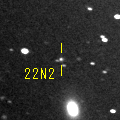
|
It is expected to brighten up to 11.5 mag in 2025 autumn, and it will be observable in good condition. Now it is 17.0 mag (Sept. 22, ATLAS South Africa). It stays 17 mag for a while. It will be getting lower gradually after this, and it will be unobservable in January.
Date(TT) R.A. (2000) Decl. Delta r Elong. m1 Best Time(A, h)
Oct. 21 20 33.19 -19 20.6 6.378 6.603 98 16.8 18:43 ( 2, 36)
Oct. 28 20 34.38 -19 13.1 6.448 6.560 92 16.8 18:35 ( 8, 36)
|
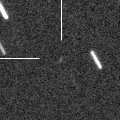
|
Now it is 17.7 mag (July 12, A. Diepvens). It stays 16 mag for a while. In the Northern Hemisphere, it will be getting higher gradually. In the Southern Hemisphere, it is not observable now, but it will appear in November.
Date(TT) R.A. (2000) Decl. Delta r Elong. m1 Best Time(A, h)
Oct. 21 11 50.82 14 12.5 2.780 2.068 36 16.9 4:46 (265, 18)
Oct. 28 11 52.78 11 43.4 2.703 2.064 41 16.8 4:51 (272, 23)
|

|
Now it is 16.9 mag (Oct. 6, Ken-ichi Kadota). Fading slowly. It will be fainter than 18 mag in January. In the Northern Hemisphere, it stays observable in good condition. In the Southern Hemisphere, it will be getting lower gradually. It was very faint as 21.5 mag in 2021. It seems to be bright temporarily in outburst.
Date(TT) R.A. (2000) Decl. Delta r Elong. m1 Best Time(A, h)
Oct. 21 21 7.53 -11 57.3 4.188 4.605 108 16.8 19:10 ( 0, 43)
Oct. 28 21 9.10 -11 51.4 4.307 4.619 102 16.9 18:44 ( 0, 43)
|
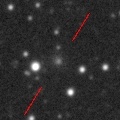
|
Now it is 16.4 mag (Oct. 15, Yukihiro Sugiyama). It stays 17 mag for a while. It will be getting lower gradually after this, and it will be unobservable in January in the Northern Hemisphere, or in December in the Southern Hemisphere.
Date(TT) R.A. (2000) Decl. Delta r Elong. m1 Best Time(A, h)
Oct. 21 18 38.97 -12 34.5 2.577 2.475 72 16.9 18:43 ( 36, 35)
Oct. 28 18 49.53 -12 35.2 2.643 2.462 68 16.9 18:35 ( 39, 33)
|

|
Now it is 17.3 mag (Oct. 12, ATLAS Chile). Fading slowly. It will be fainter than 18 mag in December. It locates somewhat low in the Northern Hemisphere. In the Southern Hemisphere, it will be getting lower gradually after this, and it will be unobservable in December.
Date(TT) R.A. (2000) Decl. Delta r Elong. m1 Best Time(A, h)
Oct. 21 18 8.29 -22 4.8 3.340 3.054 64 16.9 18:43 ( 38, 23)
Oct. 28 18 17.55 -22 7.0 3.466 3.093 60 17.0 18:35 ( 40, 21)
|

|
Now it is 16.3 mag (Oct. 17, Yukihiro Sugiyama). Fading slowly. It will be fainter than 18 mag in January. It stays observable in good condition.
Date(TT) R.A. (2000) Decl. Delta r Elong. m1 Best Time(A, h)
Oct. 21 3 54.73 5 50.7 2.213 3.092 146 17.0 2:00 ( 0, 61)
Oct. 28 3 51.34 5 23.0 2.185 3.105 153 17.0 1:29 ( 0, 60)
|
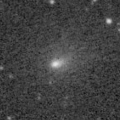
|
Now it is 16.7 mag (Sept. 5, Thomas Lehmann). It will fade out rapidly after this. It will be fainter than 18 mag in November. It stays extremely low in the Northern Hemisphere. In the Southern Hemisphere, it will be getting lower gradually.
Date(TT) R.A. (2000) Decl. Delta r Elong. m1 Best Time(A, h)
Oct. 21 19 1.31 -32 24.4 2.182 2.173 76 17.1 18:43 ( 22, 19)
Oct. 28 19 7.00 -33 58.4 2.368 2.242 70 17.4 18:35 ( 24, 16)
|

|
Now it is 17.4 mag (Oct. 17, D. Buczynski). It stays 17 mag for a while. In the Northern Hemisphere, it stays observable in good condition. It locates somewhat low in the Southern Hemisphere.
Date(TT) R.A. (2000) Decl. Delta r Elong. m1 Best Time(A, h)
Oct. 21 5 9.80 38 49.9 4.658 5.299 125 17.2 3:15 (180, 86)
Oct. 28 5 8.70 38 38.6 4.557 5.277 132 17.1 2:47 (180, 86)
|

|
The cometary activity was detected by Masayoshi Yoshimi on Sept. 15. Now it is 16.0 mag (Sept. 15, Masayoshi Yoshimi). It will fade out rapidly after this. It will be fainter than 18 mag in November. In the Northern Hemisphere, it stays observable in good condition. In the Southern Hemisphere, it will never be observable after this.
Date(TT) R.A. (2000) Decl. Delta r Elong. m1 Best Time(A, h)
Oct. 21 21 25.09 51 45.5 0.261 1.128 114 17.2 19:28 (180, 73)
Oct. 28 21 38.48 57 2.1 0.281 1.134 113 17.4 19:14 (180, 68)
|
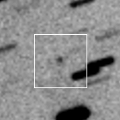
|
Now it is 17.5 mag (Oct. 7, ATLAS-HKO, Haleakala). It stays 17 mag for a while. In the Northern Hemisphere, it stays observable in good condition. In the Southern Hemisphere, it is not observable now, but it will appear in November.
Date(TT) R.A. (2000) Decl. Delta r Elong. m1 Best Time(A, h)
Oct. 21 0 15.06 57 20.6 3.692 4.402 130 17.3 22:15 (180, 68)
Oct. 28 23 55.00 56 12.3 3.682 4.385 129 17.2 21:28 (180, 69)
|
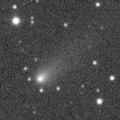
|
It brightened up to 13.8 mag in spring (Apr. 26, Thomas Lehmann). Now it is 16.6 mag (Oct. 9, ATLAS Chile). Fading slowly. It will be fainter than 18 mag in November. In the Northern Hemisphere, it will never be observable after this. It locates somewhat low in the Southern Hemisphere.
Date(TT) R.A. (2000) Decl. Delta r Elong. m1 Best Time(A, h)
Oct. 21 16 27.96 -41 12.0 3.243 2.680 47 17.3 18:43 ( 42, -6)
Oct. 28 16 43.75 -41 29.7 3.318 2.700 44 17.4 18:35 ( 43, -6)
|
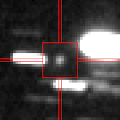
|
It is expected to brighten up to 12.5 mag in 2024 summer. Now it is 17.3 mag (July 28, ATLAS South Africa). Brightening slowly. In the Northern Hemisphere, it is not observable now. In the Southern Hemisphere, it will be getting higher gradually. Around the high light, it is observable in good condition in the Southern Hemisphere, but it locates very low in the Northern Hemisphere.
Date(TT) R.A. (2000) Decl. Delta r Elong. m1 Best Time(A, h)
Oct. 21 12 23.47 -47 23.3 5.396 4.683 40 17.4 4:46 (313,-22)
Oct. 28 12 33.24 -48 20.5 5.338 4.627 40 17.3 4:51 (316,-19)
|

|
Now it is 17.4 mag (Oct. 20, ATLAS South Africa). It stays 17 mag for a while. It stays extremely low in the Northern Hemisphere. In the Southern Hemisphere, it stays observable in good condition.
Date(TT) R.A. (2000) Decl. Delta r Elong. m1 Best Time(A, h)
Oct. 21 5 15.71 -39 9.7 7.551 7.941 109 17.4 3:20 ( 0, 16)
Oct. 28 5 14.69 -39 40.3 7.493 7.916 111 17.4 2:52 ( 0, 15)
|
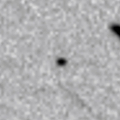
|
Now it is 18.3 mag (Oct. 9, Catalina Sky Survey). It will brighten rapidly after this. It stays observable in good condition.
Date(TT) R.A. (2000) Decl. Delta r Elong. m1 Best Time(A, h)
Oct. 21 0 22.68 2 29.8 0.752 1.720 159 17.7 22:24 ( 0, 57)
Oct. 28 0 13.52 0 7.1 0.715 1.649 149 17.4 21:47 ( 0, 55)
|
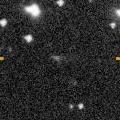
|
First return of a new periodic comet which brightened up to 15 mag in 2008. Now it is 18.1 mag (Oct. 5, Ken-ichi Kadota). It will fade out rapidly after this. It will be fainter than 18 mag in November. It stays observable in good condition.
Date(TT) R.A. (2000) Decl. Delta r Elong. m1 Best Time(A, h)
Oct. 21 4 6.18 12 22.8 1.855 2.725 144 17.8 2:11 ( 0, 68)
Oct. 28 4 2.99 10 54.0 1.841 2.756 151 17.9 1:41 ( 0, 66)
|
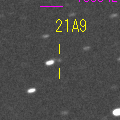
|
Now it is 18.9 mag (Sept. 25, W. Hasubick). It stays 18 mag for a while. It stays observable in good condition.
Date(TT) R.A. (2000) Decl. Delta r Elong. m1 Best Time(A, h)
Oct. 21 7 41.44 10 43.8 7.672 7.764 91 17.9 4:46 (327, 62)
Oct. 28 7 39.10 10 29.6 7.545 7.763 99 17.9 4:51 (345, 65)
|

|
It brightened up to 14 mag from 2020 to 2021. Now it is 17.9 mag (Aug. 24, W. Hasubick). Fading slowly. It will be fainter than 18 mag in November. It stays observable in good condition.
Date(TT) R.A. (2000) Decl. Delta r Elong. m1 Best Time(A, h)
Oct. 21 2 53.99 2 59.0 3.826 4.775 160 17.9 0:59 ( 0, 58)
Oct. 28 2 49.72 2 45.1 3.818 4.786 165 17.9 0:28 ( 0, 58)
|

|
It returned for the first time in 68 years. It will brighten up to 7.5 mag in 2024 summer. Now it is 18.8 mag (Oct. 18, Ken-ichi Kadota). It will brighten rapidly after this. It stays observable in good condition. At the high light, it locates low in the Northern Hemisphere, or it is not observable in the Southern Hemisphere.
Date(TT) R.A. (2000) Decl. Delta r Elong. m1 Best Time(A, h)
Oct. 21 4 20.08 -20 5.0 2.725 3.453 130 18.5 2:25 ( 0, 35)
Oct. 28 4 15.15 -20 38.5 2.617 3.384 134 18.2 1:53 ( 0, 34)
|
|
![]()
 C/2017 K2 ( PanSTARRS )
C/2017 K2 ( PanSTARRS ) 62P/Tsuchinshan 1
62P/Tsuchinshan 1 C/2021 T4 ( Lemmon )
C/2021 T4 ( Lemmon ) C/2023 S2 ( ATLAS )
C/2023 S2 ( ATLAS ) C/2019 U5 ( PanSTARRS )
C/2019 U5 ( PanSTARRS ) C/2019 L3 ( ATLAS )
C/2019 L3 ( ATLAS ) C/2023 E1 ( ATLAS )
C/2023 E1 ( ATLAS ) 29P/Schwassmann-Wachmann 1
29P/Schwassmann-Wachmann 1 C/2022 E2 ( ATLAS )
C/2022 E2 ( ATLAS ) C/2021 X1 ( Maury-Attard )
C/2021 X1 ( Maury-Attard ) C/2022 A2 ( PanSTARRS )
C/2022 A2 ( PanSTARRS ) C/2020 K1 ( PanSTARRS )
C/2020 K1 ( PanSTARRS ) C/2022 JK5 ( PanSTARRS )
C/2022 JK5 ( PanSTARRS ) 126P/IRAS
126P/IRAS C/2022 L2 ( ATLAS )
C/2022 L2 ( ATLAS ) C/2019 T4 ( ATLAS )
C/2019 T4 ( ATLAS ) C/2021 G2 ( ATLAS )
C/2021 G2 ( ATLAS ) C/2023 A3 ( Tsuchinshan-ATLAS )
C/2023 A3 ( Tsuchinshan-ATLAS ) 32P/Comas Sola
32P/Comas Sola 144P/Kushida
144P/Kushida 213P/Van Ness
213P/Van Ness C/2021 Y1 ( ATLAS )
C/2021 Y1 ( ATLAS ) 471P/2023 KF3
471P/2023 KF3 C/2022 S4 ( Lemmon )
C/2022 S4 ( Lemmon ) 199P/Shoemaker 4
199P/Shoemaker 4 C/2022 E3 ( ZTF )
C/2022 E3 ( ZTF ) 226P/Pigott-LINEAR-Kowalski
226P/Pigott-LINEAR-Kowalski 117P/Helin-Roman-Alu 1
117P/Helin-Roman-Alu 1 C/2014 UN271 ( Bernardinelli-Bernstein )
C/2014 UN271 ( Bernardinelli-Bernstein ) 237P/LINEAR
237P/LINEAR C/2022 A3 ( Lemmon-ATLAS )
C/2022 A3 ( Lemmon-ATLAS ) C/2020 Y2 ( ATLAS )
C/2020 Y2 ( ATLAS ) 71P/Clark
71P/Clark C/2021 S4 ( Tsuchinshan )
C/2021 S4 ( Tsuchinshan ) C/2019 E3 ( ATLAS )
C/2019 E3 ( ATLAS ) C/2022 QE78 ( ATLAS )
C/2022 QE78 ( ATLAS ) C/2022 N2 ( PanSTARRS )
C/2022 N2 ( PanSTARRS ) C/2022 V2 ( Lemmon )
C/2022 V2 ( Lemmon ) P/2023 M4 ( ATLAS )
P/2023 M4 ( ATLAS ) 219P/LINEAR
219P/LINEAR 81P/Wild 2
81P/Wild 2 170P/Christensen
170P/Christensen C/2022 W3 ( Leonard )
C/2022 W3 ( Leonard ) C/2022 U3 ( Bok )
C/2022 U3 ( Bok ) 2019 AV4
2019 AV4 C/2022 U1 ( Leonard )
C/2022 U1 ( Leonard ) 77P/Longmore
77P/Longmore C/2023 C2 ( ATLAS )
C/2023 C2 ( ATLAS ) C/2022 R6 ( PanSTARRS )
C/2022 R6 ( PanSTARRS ) 207P/NEAT
207P/NEAT 465P/2023 L1 ( Hill )
465P/2023 L1 ( Hill ) C/2021 A9 ( PanSTARRS )
C/2021 A9 ( PanSTARRS ) 246P/NEAT
246P/NEAT 13P/Olbers
13P/Olbers![]()


























































